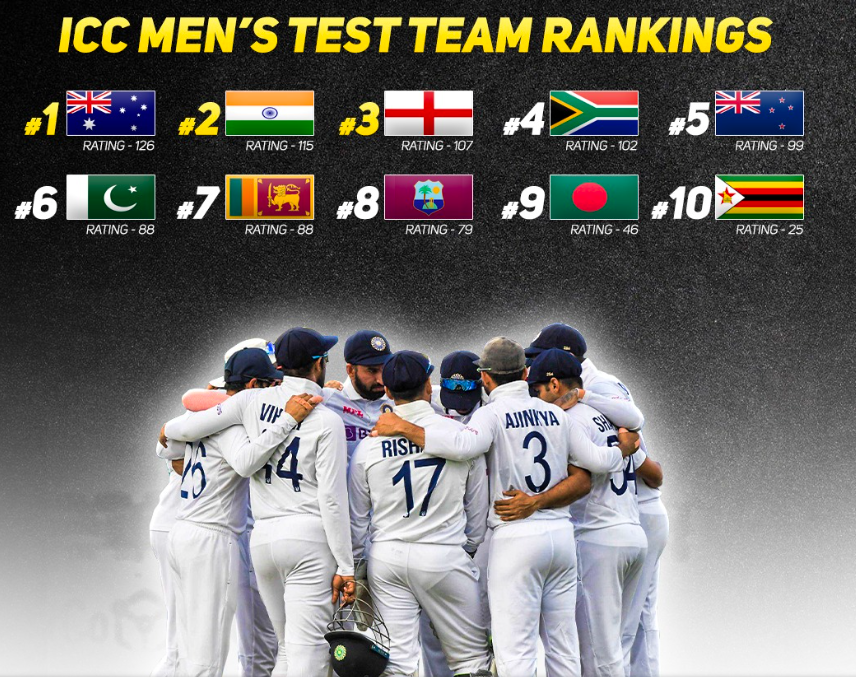
MEN’S TEST TEAM RANKINGS:
Last Updated – 11th March 2024
| POSITION | TEAM | MATCHES | POINTS | RATING |
|---|---|---|---|---|
| 1 | India | 38 | 4636 | 122 |
| 2 | Australia | 40 | 4798 | 120 |
| 3 | England | 49 | 5443 | 111 |
| 4 | South Africa | 27 | 2671 | 99 |
| 5 | New Zealand | 32 | 3140 | 98 |
| 6 | Pakistan | 29 | 2576 | 89 |
| 7 | West Indies | 31 | 2505 | 81 |
| 8 | Sri Lanka | 28 | 2212 | 79 |
| 9 | Bangladesh | 22 | 1131 | 51 |
| 10 | Zimbabwe | 7 | 223 | 32 |
| 11 | Ireland | 6 | 58 | 10 |
| 12 | Afghanistan | 5 | 0 | 0 |
The ICC Men’s Test Team Rankings is a system established by the International Cricket Council (ICC) to rank international cricket teams in the longest format of the game, Test cricket.
Introduced in 2003, these rankings provide an objective assessment of the performance and standing of Test-playing nations based on their results in Test matches over a specified period.
Here’s a detailed overview of how the ICC Men’s Test Team Rankings work:
- Calculation Methodology:
The rankings are calculated based on a complex mathematical formula that takes into account various factors such as match results, quality of opposition, series outcomes, and the relative strength of teams.
Points are awarded for wins, draws, ties, and losses in Test matches, with the weightage of each result depending on factors like home or away series, the opponent’s ranking, and the margin of victory.
2. Series Points:
Test series consist of multiple matches, usually ranging from two to five games.
Points earned by a team in a series are determined by the number of matches won, drawn, or lost.
The total points accumulated in a series contribute to the team’s overall ranking.
3. Weightage of Matches:
The ICC Men’s Test Team Rankings consider the context and significance of matches.
For instance, matches played in ICC events like the World Test Championship (WTC) carry higher weightage compared to bilateral series.
4. Periodic Updates:
The rankings are updated periodically, often after the conclusion of Test series around the world.
The frequency of updates depends on the scheduling of Test cricket fixtures.
5. Team Ratings:
Each team is assigned a rating, which represents its overall standing in Test cricket relative to other teams.
Higher ratings indicate stronger teams, while lower ratings suggest weaker performances.
6. Ranking Table:
The rankings are presented in the form of a table, where teams are listed in descending order of their ratings.
The top-ranked team holds the prestigious position of being the number one Test team in the world.
7. Historical Context:
The ICC Men’s Test Team Rankings also provide historical context, allowing cricket enthusiasts to track the performance of teams over time.
Teams can move up or down in the rankings based on their recent results.
8. Importance:
While the rankings themselves do not have any direct impact on tournament qualification or match scheduling, they serve as a barometer of a team’s form and competitiveness in Test cricket.
The number one ranking is often coveted by teams as a symbol of excellence and dominance in the longest format of the game.
Overall, the ICC Men’s Test Team Rankings play a crucial role in assessing the relative strengths of Test-playing nations and generating interest and excitement among cricket fans worldwide.

Leave a Reply